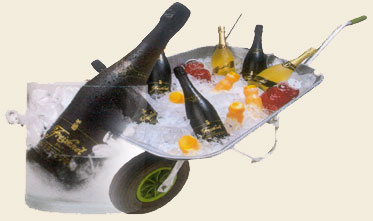


How wine is stored is a big contributor to easy temperature control: those with a cool cellar, or a cooled cabinet, will have white wines nearly cold enough at any time. Note that purpose - made wine storage cabinets are not as cold as domestic refrigerators. Do not keep wines, especially good wine, in an ordinary refrigerator for any period longer than a day or two, as they grow tired from other foods stored nearby.
An ice bucket is the quickest way to cool wine. Water as well as ice is essential: cubes of ice surrounded by air are useless as air is a poor conductor of heat, and cannot extract the warmth from the bottle. Add water, which does conduct heat, and the bottle will rapidly chill, taking 10-15 minutes to cool from 20°C to 8°C (68to 46°F). A refrigerator takes 1.5-2 hours to do the job - longer in hot weather. Once a wine is cool, an ice bucket with less ice and more water will keep it so, but beware of over chilling. An insulated container keeps a cool bottle cool for some hours. A wrapping of wet newspaper has the same effect on a picnic.
To warm a wine, bring it into a gently warm room and let it stand quietly for two to three hours. (If the dining room is hot, the hall may be cooler.) Do not place the wine near sources of heat such as stoves or radiators: the heat will set up currents in the wine, making it cloudy if there is a deposit, and in extreme cases affecting the taste. A very cold bottle of red wine can be gently warmed in a bucket of warm water.
|
|
|




